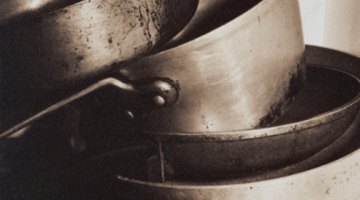How to Use Lye Water for Cleaning
Lye can be dangerously corrosive when mixed with water: But the two make an effective cleaning agent when carefully combined. The many uses of lye water include cleaning cast-iron cookware and bleaching wood for refinishing. Lye water is also sold premixed and concentrated.

This makes it easier to create a gentler cleanser for objects made from natural materials, such as wooden bowls and bamboo utensils.
Things You Will Need
- Rubber gloves
- Safety goggles
- Safety mask
- Waterproof apron
- Water
- Jar of lye crystals, 2 lb.
- Heavy-duty plastic container, at least 10 gallons
- Stainless steel spoon
- Steel wire
- Steel coat hangers
- Garden hose
- Stainless steel scouring pads or brushes
- Liquid dish soap
- Oven
- Mineral oil
- Soft cloth
- Stainless steel pot, at least 4 quarts
- Hydrogen peroxide
- Vinegar
- Wooden ladle or stainless steel potato masher
- 1 tbsp. commercial concentrated lye water
Cleaning Cast-Iron Utensils
-
Add 1 can of lye to 4 or 5 gallons of water in a plastic container. Mix with a stainless steel spoon.
-
Tie the utensils to steel coat hangers with wire.
-
Slowly immerse the utensils in the lye water. Keep them suspended in the water by hooking each hanger around the edge of the plastic container.
-
Let the utensils soak for several days, up to a week. This is enough time to properly clean them, but the utensils will not be damaged if you leave them in longer.
-
Carefully lift up each coat hanger and untie the utensils.
-
Rinse each utensil in vinegar, then in water. The vinegar neutralizes any remaining lye.
-
Wipe away any remaining grease with a steel scouring pad or brush. Soak the utensils again if necessary.
-
Wash each utensil with dish soap and warm water. Rinse thoroughly.
-
Dry the utensils in an oven set to 200 degrees Fahrenheit. Let them cool completely.
-
Apply mineral oil to the utensils with a cloth. Let them stand overnight.
-
Wipe off any excess oil with a paper towel.
Bleaching Wood Furniture
-
Mix 1 oz. lye with 1 quart of water. Let it sit until the crystals dissolve.
-
Use paper towels to apply an even coat of lye water to the wood. Let it absorb for about 15 minutes.
-
Apply an even coat of hydrogen peroxide over the treated wood. Let it sit for another 15 minutes.
-
Add another coat of lye water to the wood. Let it sit for 15 minutes, then coat with hydrogen peroxide. Apply 5 coats of each, letting the wood dry for 15 minutes between applications.
-
Wipe the wood with vinegar to remove excess lye and neutralize any residue.
-
Wipe the wood with water. The addition of water is what will cause the wood to lighten. Dry with paper towels.
Cleaning Objects Made From Natural Materials
-
Add 1 tbsp. commercial lye water to 4 cups hot water in a stainless steel pot. Bring the solution to a boil.
-
Add the object to be cleaned. Hold it under the water with a ladle or potato masher.
-
Remove the object and rinse it twice in hot water.
-
Mix 2 tbsp vinegar with 4 cups warm water. Rinse the object with the solution and follow with a plain water rinse.
Warning
Always wear gloves, goggles, a safety mask and a waterproof apron when handling lye. Gradually add the lye to the water. Never pour water onto lye. Use lye in a well-ventilated area. Do not use lye water to clean porcelain- or aluminum-coated cast-iron cookware.
The Drip Cap
- Lye can be dangerously corrosive when mixed with water: But the two make an effective cleaning agent when carefully combined.
- The many uses of lye water include cleaning cast-iron cookware and bleaching wood for refinishing.
- Rinse each utensil in vinegar, then in water.
- Wipe off any excess oil with a paper towel.
- Use paper towels to apply an even coat of lye water to the wood.
- Let it absorb for about 15 minutes.
- Add the object to be cleaned.
- Remove the object and rinse it twice in hot water.
References
Resources
Writer Bio
Megan Robb has been writing professionally since 2007. She loves art and literature, as well as volunteering for her local animal shelter. Megan's work has been featured on Cracked.com, "The Bushwick Review," GlobalGolf.com and Divot.com, as well as her own blog, Megan Robb: Writer Extraordinaire. She currently lives in Raleigh, N.C.
Photo Credits
- Danielle Weil/Photodisc/Getty Images
- Danielle Weil/Photodisc/Getty Images
More Articles



